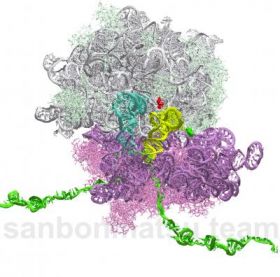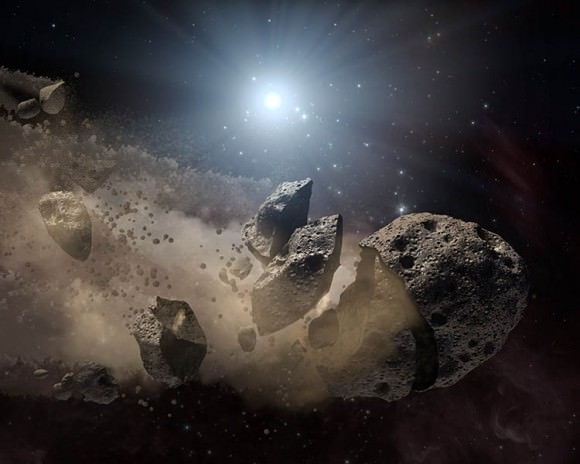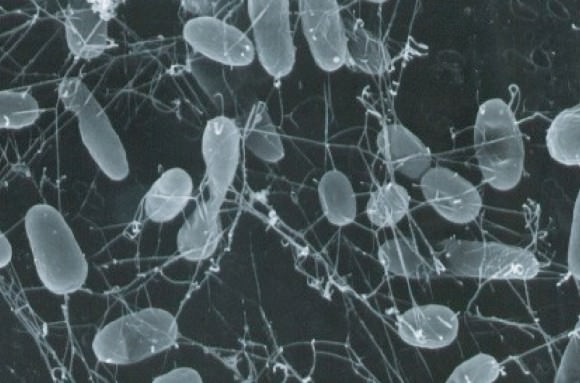No answers today, only a question. But it’s one of the most interesting and meaningful questions we can possibly ask.
Where does life come from?
How did we get from no life on Earth, to the rich abundance we see today?
Charles Darwin first published our modern theories of evolution – that all life on Earth is related; adapting and changing over time. Look at any two creatures on Earth and you can trace them back to a common ancestor. Humans and chimpanzees share a common ancestor from at least 7 million years ago.
Trace back far enough, and you’re related to the first mammal who lived 220 million years ago. In fact, you and bacteria can trace a family member who lived billions of years ago. Keep going back, and you reach the oldest evidence of life on Earth, about 3.9 billion years ago.
But that’s as far as evolution can take us.
The Earth has been around for 4.5 billion years, and those early years were completely hostile to life. The early atmosphere was toxic, and a constant asteroid bombardment churned the landscape into a worldwide ocean of molten rock.
As soon as the environment settled down to be relatively habitable, life appeared. Just half a billion years beyond the formation of the Earth.
So how did life make the jump from raw chemicals to the evolutionary process we see today? The term for this mystery is abiogenesis and scientists are working on several theories to explain it.
 One of the first clues is amino acids, the building blocks of life. In 1953, Stanley Miller and Harold Urey demonstrated that amino acids could form naturally in the environment of the early Earth. They replicated the atmosphere and chemicals present, and then used electric sparks to simulate lightning strikes.
One of the first clues is amino acids, the building blocks of life. In 1953, Stanley Miller and Harold Urey demonstrated that amino acids could form naturally in the environment of the early Earth. They replicated the atmosphere and chemicals present, and then used electric sparks to simulate lightning strikes.
Amazingly, they found a variety of amino acids in the resulting primordial soup.
Other scientists replicated the experiment, even changing the atmospheric conditions to match other models of the early Earth. Instead of water, methane, ammonia and hydrogen, they wondered what would happen if the atmosphere contained hydrogen sulfide and sulfur dioxide from volcanic eruptions. Environments around volcanic vents at the bottom of the ocean might have been the perfect places to get life started, introducing heavier metals like iron and zinc. Perhaps ultraviolet rays from the younger, more volatile Sun, or abundant radiation from natural uranium deposits played a role in pushing life forward into an evolutionary process.

Maybe it wasn’t the organic chemicals that came first, but the process of self organization. There are examples of inorganic chemicals and metals that can organize themselves under the right conditions. The process of metabolism came first, and then organic chemicals adopted this process.

So how did life get here? We just don’t know.
Maybe we’ll discover life on other worlds and that will give us a clue, or maybe scientists will create an experiment that finally replicates the jump from non-life to life.
We may never discover the answer.


It is interesting that much the same biochemistry evolves in acidic, neutral or alkaline water environments. It is more (and perhaps vitally so) a matter of productivity.
The question where life comes from has been fairly constrained lately. If we use the idea of Lane and Martin of trait homologies, not restricting traits in phylogenetic modeling to biological populations, evolution reaches deeper and becomes more constrained. E.g. looking at what traits cellular lifeforms share with their environment. [“The Origin of Membrane Bioenergetics”, Lane and Martin, Cell 2012]
1. The old observation of cell main constituents, CHNOPS elements (e.g. Carbon, Hydrogen, et cetera), being the most frequent chemically active elements can then be understood as a test of the hypothesis that biological evolution was a product of chemical evolution. Why else the same elements?
That is 6 independent tests of the same hypothesis, 1 for each element.
And if you think about it, populations of chemicals are quite alike populations of organisms. They can coevolve under natural selection, go extinct, et cetera.
2. Lane’s & Martin’s trait homology between pH modulated chemistry of alkaline hydrothermal vents and early chemoautotroph metabolism tests that life on Earth arose from hydrothermal vents. Why else the same chemistry? [Ibid]
That is 3 or more independent tests of the same hypothesis (chemistry, magnitude of pH differential, direction of pH differential: so called chemoosmosis over a membrane, whether a thin inorganic FeS or a thin organic lipid membrane, so that H is stored in the more acid environment for later energy use).
And since Earth would have had the largest density (largest surface) of such vents among the then habitable terrestrials, it is most likely life arose locally.
Russell and his lab just got 8 MUSD from NASA to look at this type of abiogenesis.
That there is a shadow ecosystem is very unlikely, seeing how many organisms we have found that arose from a universal common ancestor.
What is up in the air is how metabolism in a membrane coupled to replication in a membrane.
That coupling could even have been fortuitous. It was recently found that the set of nucleobases and the sugar used in nucleotides that goes into RNA are those that most stabilize a lipid membrane in a salty environment. [“Nucleobases bind to and stabilize aggregates of a prebiotic amphiphile, providing a viable mechanism for the emergence of protocells”, Black et al, PNAS 2013.]
– The pathway may then have been that inorganic compartments became less leaky and extended by nucleobase and sugar stabilized lipid membranes.
– The incorporated RNA constituents could later supplement the energy cycle (ATP) and the chemical cycle (ribozymes).
A recent result is that under Archean conditions (no oxygen, lots of iron in the II oxidation state), RNA with iron(II) as cofactor can catalyze the most demanding chemistry of electron transfer just as modern protein enzymes. And a test that it happened before modern enzyme metabolism was mature is that precisely the oldest and most conserved RNA, tRNA and rRNA, does it while modern viral mRNA doesn’t do it at all. [“RNA with iron(II) as a cofactor catalyses electron transfer”, Hsiao et al, Nature Chemistry 2013.]
– Later still the RNA strand populations growing ability to remember “self” would have promoted protocell colonization of new vents. With a typical halflife of 4 years before hydrolysis, they were quite sturdy compared with other protocell components (such as early membranes).
quoting geniuses doesn’t make life closer to understanding.
Here’s a paper calculating beginning of life based on increasing complexity, similar to Moor’s Law. Their calculation shows life started about 9.7 billion years ago.
Life Before Earth
http://arxiv.org/abs/1304.3381
I have a hard time take this paper seriously. If we look at genome clocks they correlate with the trace fossil record and arrive at a start time for our biosphere at about 4 billion years ago.
An analogy would be that it is arguing for that Earth is older than the solar system, it could happen despite that isotope clocks correlate with meteorite isotope clocks. So I will not look at the paper specifically but as a sample of an old industry of similar papers.
These types of papers have been used for two different reasons.
One is the old use of Hoyle et al, where his creationist thinking was tied to his steady state universe (which would have been his antidote to his “747 in a junkyard wind” model), and attempts to support transpermia.
More recently these papers have been used by futurists to predict “singularities” from “increasing complexity”.
I’m not a biologist, but it is my understanding that most biologists don’t think that life has seen increasing “complexity” however you measure it. More precisely they concur with Gould, which noted that life started out simple so it had to diffuse towards more genes and multicellularity as is possible. But evolution in itself is undirected, and as the ~ 40 % parasites shows it simplifies body plans as often as it complexifies.
In other words we are not so much more complex, using genes as proxy for complexity, than the common ancestor (CA). The average bacteria genome has ~2x times as many genes as the universal CA prokaryote and similarly the average eukaryote has ~ 3x times as many genes as the CA eukaryote.
There is a debate within biology if there are some sort of inherent trend towards complexity (however defined). I don’t think I’ve seen anything out of that yet.
Even the futurists are wrong. IIRC our energy budget (Lane) can’t support much more than twice the current brain/body ratio, taking the number of synapses/body mass as a proxy for complexity. There is a complexity maximum.
So it is a possible hypothesis, same as it is possible Earth isn’t derived from the solar system, but it isn’t very likely.
Thank you for taking your time checking it.
I don’t know enough to have a decent opinion about it, just thought it might add to the discussion.
This are things i liked about it :
– assumption of possibility that complex organics could self assemble in space as i recently read a paper, showing that quantum effects could enable chemistry of complex organics at temperatures much lower than required for liquid water and, IIRC, without need for water either. There is also evidence of amino acids being created in non-planetary environment, so no real news, but that other paper was talking about more complex molecules.
– idea of oil micro-capsules containing enzymes creating some kind of closed cell-like environment.
Rest, i’m learning 🙂
Too much time is spent questioning where life came from and not enough on where it’s going. Fukushima is on the brink of exterminating all life in the northern hemisphere while scientists are pondering theories. How about some smart engineers getting together and entombing that thing and saving the world?
Jesus what a kind of crap did you listen to.
I agree with you. It is time to act and not speculate. The origin of life is important, but more important is to save it!
While high minded scientists are blathering about where life came from,
Cesium 137 is streaming from Fukushima, is in all our air, food and water and lasts 20,000 years. It’s just a matter of time before we all die of cancer. Gamma rays are THE most dangerous, deadly poison on earth. Children are most susceptible. It’s time to SAVE THE CHILDREN!
Astrobiology hints that it’s likely that there are many different possibilities that serve to start “life”, each occurring in radically different extrasolar environments. But sadly here we are over half a century since the start of the space age and we still have zero proof and not even likely evidence of life anywhere else. We could live in a universe of 10 exp 30 planets but where the probability of life starting even once is 10 exp-30 or worse. I doubt it, but the possibility is not falsified by science.
I think I have described many times on UT precisely how that possibility is rejected by observation: life is frequent.
With the current observations of the first trace fossils, Isua @ 3.8 Ga bp, life arose within 0.7 Ga during a 4.5 Ga observation period. The simplest possible stochastic model predicting the outcome of abiogenesis attempts and their success would be a Poisson model, and a sample at a normed 0.16 means a 3 sigma test of low delay time (normed delay < 0.2).
This is simply because Possion process stacks the probability density early (exponential distribution) so it happens to make for a test, and using single samples are sufficient for say process control. You could claim that different planets could have different processes (certainly the pathways will differ in detail), but I think Lane & Martin shows it is unlikely and even if not this would likely be a sample out of the most likeliest process.
All this is arguable of course, but I think it points out what we see elsewhere, if a process is possible it is unlikely to result in just one specimen and the default here is specifically that life is a frequent outcome.
He didn’t quote anybody. He used a source, and this is a science website. It’s what we do here. We talk about science. Try taking off your hipster snark-o-vision glasses
I bought these glasses for cheap overseas because I’m all about American consumerism. I was simply stating an opinion, making fun of my appearance when you have a blank picture makes you a fool, and even if you did have some sort of likeness here it still makes you a fool. And I meant what I typed, that’s why I typed it. I wasn’t trolling anything.
And I know what this site is, I frequent it everyday.
I think you mean “closer to understanding life”.
Life is well understood as the constituents of the well known process of biological evolution. And as for how chemical evolution resulted in biological evolution, as I already demonstrated above it is much more known, more constrained, now than say 2 years ago.
I assume you are trolling the rest, i.e. tries a variant of the usual trope of “science is elitist”. Ordinarily I wouldn’t respond but since it is obvious: yes, it doesn’t take a genius to see that it is so through and through. Else it wouldn’t work (no market of ideas), and what would be the usefulness of that?
How about asteroid impacts providing energy and compounds for synthesis of prebiotic molecules ?
“A new study indicates that icy comets impacting the early Earth may have
produced building blocks for life on our planet. Impact events could
have supplied the energy to form organic compounds from simple molecules
in comets, such as water, ammonia and methanol.
”
http://www.astrobio.net/pressrelease/5646/the-shocking-source-for-lifes-origins
Life might have started on Mars :
“”It’s only when molybdenum becomes highly oxidized that it is able to
influence how early life formed,” explains Professor Benner, from the
Westheimer Institute for Science and Technology in the USA. “This form
of molybdenum couldn’t have been available on Earth at the time life
first began, because three billion years ago the surface of the Earth
had very little oxygen, but Mars did. It’s yet another piece of evidence
which makes it more likely life came to Earth on a Martian meteorite,
rather than starting on this planet.””
http://astrobiology.com/2013/08/new-research-supports-theory-that-life-started-on-mars.html
Sorry man, I didn’t mean to make you cry.
Far from it, tool.